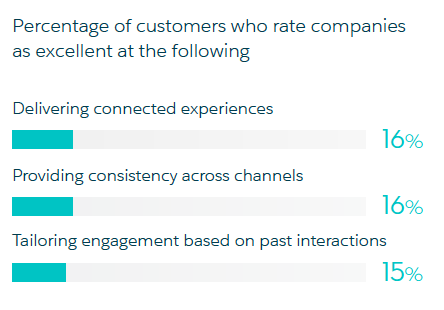
Get your FREE 30-day trial.
Please complete all fields.
My morning started today courtesy of a voice assistant reading me the news headlines and weather updates. When I get home tonight, I know there will be a package of household sundries on my doorstep, refilling a monthly order. And throughout the day, my life will be made a little easier with reading recommendations, product offers, and general conveniences that adapt to my preferences and feedback.
Of course, this story is far from unique. Today’s customers are reveling in an unprecedented standard of engagement from companies. They’re no longer satisfied with personalized experiences alone; they now expect every brand interaction to be a connected experience that reflects their actions and behaviors, is consistent across touchpoints, and generally treats them like humans. This higher standard of engagement has now become table stakes, with 70% of customers surveyed saying that connected experiences — whether it’s a seamless handoff between departments or a tailored engagement based on past interactions — are very important to winning their business. (CLICK TO TWEET)
To deliver these connected experiences at scale, businesses must have a connected, data-driven view of their customers across marketing, sales, commerce, and service. Unfortunately, many companies fall short. A new research report from Salesforce explores this topic from the perspective of a global sample of IT, marketing, sales, and service professionals to discover:
Why connected experiences are a business imperative
What challenges business and technical teams face in creating connected customer experiences
How top IT teams do it differently (and better) than their competitors.
The full report is available to download below, but here are a few of the key takeaways:
Business units across companies are pivoting their strategies to keep up with growing customer expectations and focusing on connected experiences powered by data. Despite their best intentions, however, they still face an uphill battle: the average digital transaction spans an incredible 35 systems (CLICK TO TWEET), impacting a business’s ability to deliver contextualized engagement. Customers have taken note; a mere 16% say they’d rate companies as “excellent” at providing consistency across channels and only 15% say that companies excel at tailoring engagement based on past interactions.

IT departments are coming under increasing pressure to enable a connected view of the customer for their business — and their strategic priorities reflect it. Modernizing legacy systems and integrating SaaS apps rank as the two most common IT objectives. Moreover, antiquated legacy systems coupled with scattered data sources make doing this at scale a challenging endeavor.
As a stopgap measure, teams have resorted to a hodgepodge of point-to-point connections between individual pairs of apps that — in reality — only add complexity. In fact, 81% of IT leaders say that point-to-point integration has created some of the biggest headaches they’ve seen. (CLICK TO TWEET) Worst of all, these teams have little to show for their efforts, with only an average of 29% of enterprise applications connected. (CLICK TO TWEET)

High-performing IT teams – those at companies that outperform their competition – are 1.7X more likely than underperforming teams to integrate with a specific data focus in mind: unifying data sources for the business user — which in turn empowers the connected experiences that customers demand. Top teams take into account the specific needs of not just the business in general, but also individual departments and users. It’s only with this mindset that integration can be relevant to the unique perspectives of the business user, and thus the customers they must win over.

Download the full research report for a deep dive on connected experiences, system integration, and the roles they play in today’s business landscape.